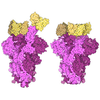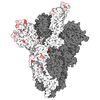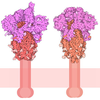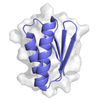[English] 日本語
 Yorodumi
Yorodumi- PDB-9js4: Cryo-EM structure of neutralizing antibody 8G3 in complex with BA... -
+ Open data
Open data
- Basic information
Basic information
| Entry | Database: PDB / ID: 9js4 | |||||||||||||||||||||||||||
|---|---|---|---|---|---|---|---|---|---|---|---|---|---|---|---|---|---|---|---|---|---|---|---|---|---|---|---|---|
| Title | Cryo-EM structure of neutralizing antibody 8G3 in complex with BA.1 RBD | |||||||||||||||||||||||||||
 Components Components |
| |||||||||||||||||||||||||||
 Keywords Keywords | VIRAL PROTEIN / SARS-CoV-2 / neutralizing antibody / RBD | |||||||||||||||||||||||||||
| Function / homology |  Function and homology information Function and homology informationMaturation of spike protein / viral translation / Translation of Structural Proteins / Virion Assembly and Release / host cell surface / host extracellular space / symbiont-mediated-mediated suppression of host tetherin activity / Induction of Cell-Cell Fusion / structural constituent of virion / entry receptor-mediated virion attachment to host cell ...Maturation of spike protein / viral translation / Translation of Structural Proteins / Virion Assembly and Release / host cell surface / host extracellular space / symbiont-mediated-mediated suppression of host tetherin activity / Induction of Cell-Cell Fusion / structural constituent of virion / entry receptor-mediated virion attachment to host cell / membrane fusion / Attachment and Entry / host cell endoplasmic reticulum-Golgi intermediate compartment membrane / positive regulation of viral entry into host cell / receptor-mediated virion attachment to host cell / host cell surface receptor binding / symbiont-mediated suppression of host innate immune response / receptor ligand activity / endocytosis involved in viral entry into host cell / fusion of virus membrane with host plasma membrane / fusion of virus membrane with host endosome membrane / viral envelope / virion attachment to host cell / SARS-CoV-2 activates/modulates innate and adaptive immune responses / host cell plasma membrane / virion membrane / identical protein binding / membrane / plasma membrane Similarity search - Function | |||||||||||||||||||||||||||
| Biological species |  Homo sapiens (human) Homo sapiens (human) Homo heidelbergensis (Heidelberg man) Homo heidelbergensis (Heidelberg man) Severe acute respiratory syndrome coronavirus Severe acute respiratory syndrome coronavirus | |||||||||||||||||||||||||||
| Method | ELECTRON MICROSCOPY / single particle reconstruction / cryo EM / Resolution: 3.8 Å | |||||||||||||||||||||||||||
 Authors Authors | Li, J. / Li, H. | |||||||||||||||||||||||||||
| Funding support |  China, 1items China, 1items
| |||||||||||||||||||||||||||
 Citation Citation |  Journal: Proc Natl Acad Sci U S A / Year: 2025 Journal: Proc Natl Acad Sci U S A / Year: 2025Title: Rapid restoration of potent neutralization activity against the latest Omicron variant JN.1 via AI rational design and antibody engineering. Authors: Yunji Liao / Hang Ma / Zhenyu Wang / Shusheng Wang / Yang He / Yunsong Chang / Huifang Zong / Haoneng Tang / Lei Wang / Yong Ke / Huiyu Cai / Ping Li / Jian Tang / Hua Chen / Aleksandra ...Authors: Yunji Liao / Hang Ma / Zhenyu Wang / Shusheng Wang / Yang He / Yunsong Chang / Huifang Zong / Haoneng Tang / Lei Wang / Yong Ke / Huiyu Cai / Ping Li / Jian Tang / Hua Chen / Aleksandra Drelich / Bi-Hung Peng / Jason Hsu / Vivian Tat / Chien-Te K Tseng / Jingjing Song / Yunsheng Yuan / Mingyuan Wu / Junjun Liu / Yali Yue / Xiaoju Zhang / Ziqi Wang / Li Yang / Jing Li / Xiaodan Ni / Hongshi Li / Yuning Xiang / Yanlin Bian / Baohong Zhang / Haiyang Yin / Dimiter S Dimitrov / John Gilly / Lei Han / Hua Jiang / Yueqing Xie / Jianwei Zhu /    Abstract: The rapid evolution of the viral genome has led to the continual generation of new variants of SARS-CoV-2. Developing antibody drugs with broad-spectrum and high efficiency is a long-term task. It is ...The rapid evolution of the viral genome has led to the continual generation of new variants of SARS-CoV-2. Developing antibody drugs with broad-spectrum and high efficiency is a long-term task. It is promising but challenging to develop therapeutic neutralizing antibodies (nAbs) through in vitro evolution based on antigen-antibody binding interactions. From an early B cell antibody repertoire, we isolated antibody 8G3 that retains its nonregressive neutralizing activity against Omicron BA.1 and various other strains in vitro. 8G3 protected ACE2 transgenic mice from BA.1 and WA1/2020 virus infection without adverse clinical manifestations and completely cleared viral load in the lungs. Similar to most IGHV3-53 antibodies, the binding sites of 8G3 and ACE2 largely overlap, enabling competition with ACE2 for binding to RBD. By comprehensively considering the binding free energy changes of the antigen-antibody complexes, the biological environment of their interactions, and the evolutionary direction of the antibodies, we were able to select 50 mutants. Among them, 11 were validated by experiments showing better neutralizing activities. Further, a combination of four mutations were identified in 8G3 that increased its neutralization potency against JN.1, the latest Omicron mutant, by approximately 1,500-fold, and one of the mutations led to an improvement in activity against multiple variants to a certain extent. Together, we established a procedure of rapid selection of neutralizing antibodies with potent SARS-CoV-2 neutralization activity. Our results provide a reference for engineering neutralizing antibodies against future SARS-CoV-2 variants and even other pandemic viruses. | |||||||||||||||||||||||||||
| History |
|
- Structure visualization
Structure visualization
| Structure viewer | Molecule:  Molmil Molmil Jmol/JSmol Jmol/JSmol |
|---|
- Downloads & links
Downloads & links
- Download
Download
| PDBx/mmCIF format |  9js4.cif.gz 9js4.cif.gz | 115.7 KB | Display |  PDBx/mmCIF format PDBx/mmCIF format |
|---|---|---|---|---|
| PDB format |  pdb9js4.ent.gz pdb9js4.ent.gz | 70 KB | Display |  PDB format PDB format |
| PDBx/mmJSON format |  9js4.json.gz 9js4.json.gz | Tree view |  PDBx/mmJSON format PDBx/mmJSON format | |
| Others |  Other downloads Other downloads |
-Validation report
| Summary document |  9js4_validation.pdf.gz 9js4_validation.pdf.gz | 380.7 KB | Display |  wwPDB validaton report wwPDB validaton report |
|---|---|---|---|---|
| Full document |  9js4_full_validation.pdf.gz 9js4_full_validation.pdf.gz | 382.7 KB | Display | |
| Data in XML |  9js4_validation.xml.gz 9js4_validation.xml.gz | 9.2 KB | Display | |
| Data in CIF |  9js4_validation.cif.gz 9js4_validation.cif.gz | 13.6 KB | Display | |
| Arichive directory |  https://data.pdbj.org/pub/pdb/validation_reports/js/9js4 https://data.pdbj.org/pub/pdb/validation_reports/js/9js4 ftp://data.pdbj.org/pub/pdb/validation_reports/js/9js4 ftp://data.pdbj.org/pub/pdb/validation_reports/js/9js4 | HTTPS FTP |
-Related structure data
| Related structure data |  61766MC M: map data used to model this data C: citing same article ( |
|---|---|
| Similar structure data | Similarity search - Function & homology  F&H Search F&H Search |
- Links
Links
- Assembly
Assembly
| Deposited unit | 
|
|---|---|
| 1 |
|
- Components
Components
| #1: Antibody | Mass: 23723.164 Da / Num. of mol.: 1 Source method: isolated from a genetically manipulated source Source: (gene. exp.)  Homo sapiens (human) / Production host: Homo sapiens (human) / Production host:  |
|---|---|
| #2: Antibody | Mass: 23338.207 Da / Num. of mol.: 1 Source method: isolated from a genetically manipulated source Source: (gene. exp.)  Homo heidelbergensis (Heidelberg man) / Production host: Homo heidelbergensis (Heidelberg man) / Production host:  |
| #3: Protein | Mass: 137337.391 Da / Num. of mol.: 1 / Fragment: RBD domain Source method: isolated from a genetically manipulated source Source: (gene. exp.)  Severe acute respiratory syndrome coronavirus Severe acute respiratory syndrome coronavirusStrain: BA.1, Omicron / Gene: S, 2 / Production host:  |
| Has protein modification | Y |
-Experimental details
-Experiment
| Experiment | Method: ELECTRON MICROSCOPY |
|---|---|
| EM experiment | Aggregation state: PARTICLE / 3D reconstruction method: single particle reconstruction |
- Sample preparation
Sample preparation
| Component | Name: Cryo-EM structure of neutralizing antibody 8G3 in complex with BA.1 RBD Type: COMPLEX / Entity ID: all / Source: RECOMBINANT |
|---|---|
| Source (natural) | Organism:  |
| Source (recombinant) | Organism:  |
| Buffer solution | pH: 5.5 |
| Specimen | Embedding applied: NO / Shadowing applied: NO / Staining applied: NO / Vitrification applied: YES |
| Vitrification | Cryogen name: ETHANE |
- Electron microscopy imaging
Electron microscopy imaging
| Experimental equipment |  Model: Titan Krios / Image courtesy: FEI Company |
|---|---|
| Microscopy | Model: TFS KRIOS |
| Electron gun | Electron source:  FIELD EMISSION GUN / Accelerating voltage: 300 kV / Illumination mode: FLOOD BEAM FIELD EMISSION GUN / Accelerating voltage: 300 kV / Illumination mode: FLOOD BEAM |
| Electron lens | Mode: BRIGHT FIELD / Nominal defocus max: 2000 nm / Nominal defocus min: 1000 nm |
| Image recording | Electron dose: 50 e/Å2 / Film or detector model: FEI FALCON IV (4k x 4k) |
- Processing
Processing
| CTF correction | Type: PHASE FLIPPING AND AMPLITUDE CORRECTION | ||||||||||||||||||||||||
|---|---|---|---|---|---|---|---|---|---|---|---|---|---|---|---|---|---|---|---|---|---|---|---|---|---|
| 3D reconstruction | Resolution: 3.8 Å / Resolution method: FSC 0.143 CUT-OFF / Num. of particles: 118107 / Symmetry type: POINT | ||||||||||||||||||||||||
| Refinement | Cross valid method: NONE Stereochemistry target values: GeoStd + Monomer Library + CDL v1.2 | ||||||||||||||||||||||||
| Displacement parameters | Biso mean: 43.78 Å2 | ||||||||||||||||||||||||
| Refine LS restraints |
|
 Movie
Movie Controller
Controller


 PDBj
PDBj





